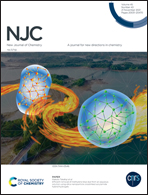Two-dimensional layered type-II MS2/BiOCl (M = Zr, Hf) van der Waals heterostructures: promising photocatalysts for hydrogen generation†
Abstract
Sustainable hydrogen (H2) production via photocatalytic water splitting is considered the most promising form of energy storage, in which two-dimensional van der Waals heterostructures, composed of two or more 2D monolayer materials, have emerged as excellent H2 storage materials. Here, we have designed two-dimensional vertical ZrS2(HfS2)/BiOCl vdW heterostructures and estimated their electronic and optical properties and the effects of applying strain using hybrid density functional theory calculations. The energetic, dynamic and thermal stabilities were verified via the interface adhesion energy, phonon dispersion curve and molecular dynamics simulations. ZrS2(HfS2) and BiOCl are stacked through weak van der Waals forces, leading to easy growth of the heterostructures. The results show that ZrS2(HfS2)/BiOCl heterostructures possess an intrinsic type-II band alignment that could efficiently reduce the recombination rate of charge carriers. Moreover, the in-plane biaxial strain tunes the bandgap and induces a transition from indirect to direct semiconductor. Additionally, the ZrS2/BiOCl heterostructure band alignment can straddle the water redox potential at pH 0–7. Our theoretical findings are beneficial in revealing the mechanism of enhanced photocatalysis and provide strategies to improve the performance of 2D monolayer materials in solar energy conversion and optoelectronic devices.



 Please wait while we load your content...
Please wait while we load your content...